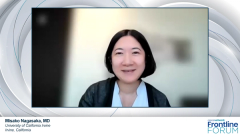
First- and Second-Line Treatment Options for EGFR Exon20+ NSCLC
Key opinion leaders in non–small cell lung cancer management reflect on the current first- and second-line treatment options available to patients with EGFR Exon20+ disease.
Episodes in this series

Transcript:
Joshua K. Sabari, MD: Moving into the treatment, say you identify a patient with newly diagnosed stage IV non–small cell lung cancer, harboring an EGFR exon 20 insertion mutation. What’s your first line of therapy for this patient in your practice?
Misako Nagasaka, MD: Yes. My choice would be clinical trials vs platinum-based chemotherapy.
Joshua K. Sabari, MD: I agree. Are you using a PD-1 or PD-L1 inhibitor here? A lot of people in the community practice are still using the KEYNOTE-189 [NCT02578680] regimen in this patient population. Is it wrong to use pembrolizumab, for example, plus chemotherapy in this group of patients?
Misako Nagasaka, MD: I don’t think it’s wrong, but I don’t think it’s right either. I tend not to use immunotherapy. I tend to use platinum-based doublet chemotherapy in this space because we’re still learning about the potential risks of treatment in this particular space, in the EGFR exon 20 insertion–mutated space. I don’t think there [are] much data with amivantamb. But if you’re thinking about second-line use of mobocertinib, I believe there was a publication or a poster or some presentation on the increased risk of adverse events when patients were given immunotherapy and were treated with mobocertinib for second line. I believe that adverse events were increased in general, and it wasn’t immune-related adverse events, so it’s hard to make sense of that data. But as we’re still learning in that space, and as there could be other tyrosine kinase inhibitor trials that I might be able to offer patients, I try to avoid the use of PD-1 inhibitors in this space.
Joshua K. Sabari, MD: I agree. It’s an interesting population because upward of 50% of patients with EGFR exon 20 insertion mutations are former smokers, or even active smokers for that matter. Whereas a patient who never smoked, that patient population—I agree with you—doesn’t derive any benefit from immunotherapy. But your second point hits home closely because we always worry about subsequent therapy and potential toxicity with subsequent therapy, primarily post a PD-1 or PD-L1 inhibitor. And for that reason, I try to keep immunotherapy, PD-1, PDL-1 checkpoint inhibitors in my back pocket. And I agree with you, Dr Nagasaka. I’m using chemotherapy in the frontline setting, usually a platinum doublet with carboplatin and pemetrexed. Now, response rates we know are in that 30%, maybe low 40%, range, and progression-free survival [PFS] is about 6 to 7 months. So chemotherapy has a lot to be desired in the frontline setting. And unfortunately, chemotherapy does not cure patients, and all our patients will unfortunately have progression in the frontline setting. So in a patient with EGFR exon 20 insertion–mutant non–small cell lung cancer, whom you’ve treated with frontline carboplatin and pemetrexed who has progression. And we’re not talking about oligometastatic progression that you can radiate or treat locally. I’m talking about widespread progression in multiple areas. What is your next line of therapy, or what are your next options for treatment in this setting?
Misako Nagasaka, MD: Based on National Comprehensive Cancer Network guidelines, the 2 options that you have are amivantamb and mobocertinib. One is IV [intravenous], and one is an oral. So I do bring up those options, as well as clinical trials for that matter, as options for patients, and then we have a discussion. I tend to prefer using amivantamb. I’m a bit biased because I have the studies, I’m comfortable using it, I believe that perhaps the response rates are slightly better. But both are options.
Transcript edited for clarity.
Newsletter
Stay up to date on recent advances in the multidisciplinary approach to cancer.





















































































